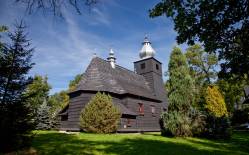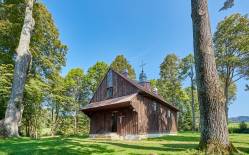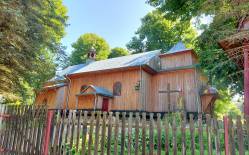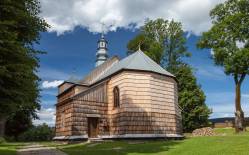The wooden Greek-Catholic Tserkva of Archangel Michael was built in 1791 at a location of an older church, mentioned in historic records from 1589, and burnt down by Tatars. In 2013 the landmark was listed as UNESCO World Heritage Site.
In 1951 the former inhabitants of the village were forcefully relocated. Their houses were dismantled and the abandoned tserkva was used as hay storage. This was when the dome and the walls where whitewashed, and in the process - the wall paintings were destroyed. The preserved church furnishings and icons were moved to the Icon Repository in Łańcut.
Restoration works were carried out here in 1969−1973. Only traditional, manual methods were applied and no mechanical tools were used in the process. In 1974 the religious functions of the building were reinstated and it was transformed into the Roman Catholic church of the Assumption of the Blessed Virgin Mary.
Currently this is one of the four archaic-style tserkvas representing the co-called simple Bojko style. It is a three-part log church, oriented eastward. Its upper part is clad with shingles and the lower part has been covered with wood planks recently. The skirt roof running along the entire perimeter of the building is supported on protruding log tails. The chancel, the nave and the narthex are covered with tented roofs, topped with small pinnacles.
Inside we can see a log structure of the cupola ceiling with visible wooden braces. In the altar, behind the tabernacle, there are Royal Doors brought from Kuryłówka. Evoking the shrub-vine, the Doors feature four medallions with figures of the Evangelists. The cupola ceiling over the chancel is embellished with a painting which imitates the celestial sphere. On the walls there are ornamental paintings. A suspended choir gallery is located along the western wall of the nave. The paintings and interior furnishings were brought from various churches.
Until recently, traces of bear claws were visible on the eastern wall of the chancel. On the northern side of the church there is a cemetery with a few interesting tombstones.
Photo: Krystian Kłysewicz, Wiktor Baron
Gallery
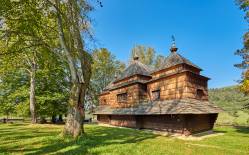
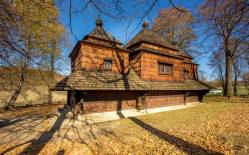
Recommended venues on the Trail



This website has been modernized with the financial support of the European Union under the Cross-Border Cooperation Programme Poland-Belarus-Ukraine 2014-2020. The responsibility for its content lies solely with the Podkarpackie Regional Tourism Board and cannot, in any case, be treated as a reflection of the position of the European Union, the Managing Authority, or the Joint Technical Secretariat of the Cross-Border Cooperation Programme Poland-Belarus-Ukraine 2014-2020.











